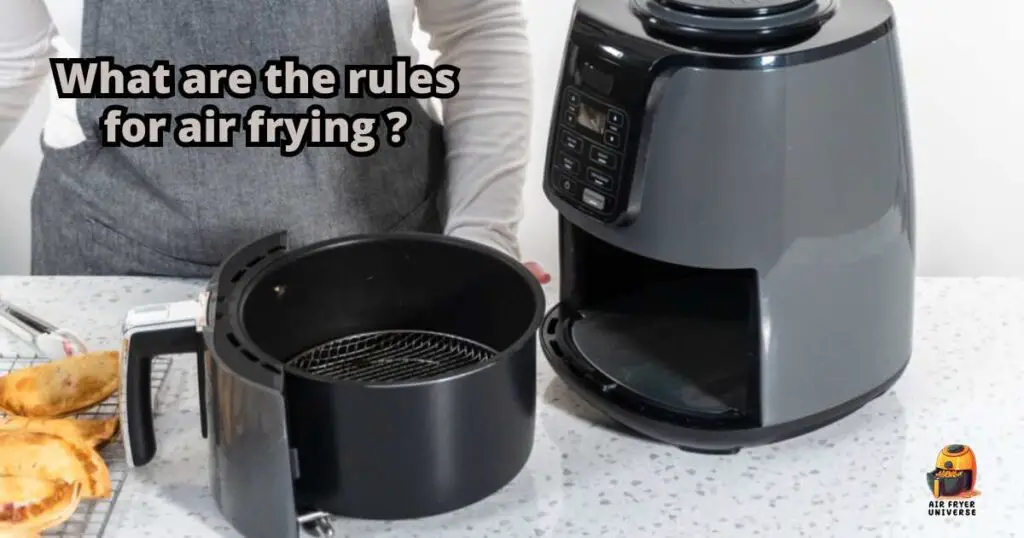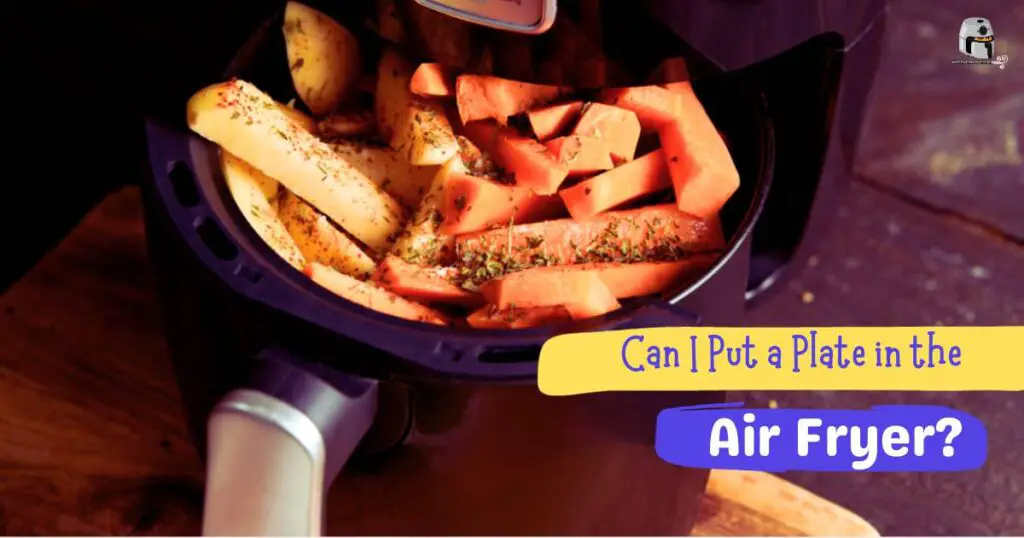Air frying comes with a few essential rules to ensure successful results. First, maintain the right temperature, typically around 350°F to 400°F (175°C to 200°C), adjusting as needed for specific recipes. Preheat your air fryer for even cooking. Use minimal oil, typically a light coating, to achieve a crispy texture without excessive greasiness.
You can cook frozen foods directly, but add a few extra minutes to the cooking time. To prevent sticking, lightly oil the basket or use parchment paper, and remember to shake the basket during cooking for even browning. These rules make air frying efficient and enjoyable.

What Are the Rules for Air Frying- 22 Basic rules
Air frying is a versatile and efficient cooking method, but to make the most of it, you need to follow some essential rules:
Rule 1: Always Preheat Your Air Fryer
Preheating is essential as it ensures that the air fryer reaches the desired cooking temperature before you start. It’s comparable to preheating an oven, and it significantly impacts the cooking process. To preheat your air fryer, set it to the required temperature and let it run for a few minutes.
Rule 2: Choose the Right Cooking Temperature
Selecting the correct temperature is crucial for successful air frying. Different recipes require different temperatures, and getting it right ensures that your food is cooked to perfection. Air fryers typically operate between 300-400°F (150-200°C), but specifics depend on what you’re cooking.
Rule 3: Don’t Overcrowd the Basket
Air fryers, despite their bulky look, usually have limited basket space. To ensure even cooking and prevent food from sticking together, avoid overloading the basket. Place items in a single layer with some spacing in between to allow hot air to circulate. Refrain from stacking or overcrowding; this ensures your dishes cook evenly and come out perfectly.
Rule 4: Use Cooking Oil Sparingly
Air frying is known for using less oil than traditional frying methods. When using oil, apply it efficiently using an oil sprayer or brush. In many cases, you’ll find that a small amount is sufficient to achieve the desired crispiness without excess calories.
Rule 5: Use Bread to Your Advantage
Managing fatty meats in an air fryer can be messy. To streamline cleanup, slip a piece of soft white bread between the inner basket and the removable bin. The bread absorbs excess oil, simplifying the cleaning process. Afterward, discard the bread, wash it with soap and water, and your air fryer is ready in no time.
Rule 6: Ignore the Presets
With the exception of the preheat function, preset buttons often have limited utility. Frozen fries differ, and defrosting isn’t a typical need. Have confidence in your judgment. Air fryers are forgiving, and you can keep an eye on your food with minimal disruption, unlike conventional ovens.
Rule 7: Flip It and Reverse It
Several air fryers come with a handy mid-cooking beep to prompt you to flip or shake your food. When cooking larger items like chicken wings, use tongs to flip them halfway through. For smaller items such as veggies and fries, shaking the basket is effective, but do so multiple times for even cooking.
Rule 8: Use a Dedicated Outlet and Unplug When Finished
To prevent potential electrical fires, always unplug your air fryer when not in use. Make sure kitchen appliances are directly plugged into an outlet rather than using extension cords. Be cautious of the air fryer’s hot air blowing at electrical outlets to avoid issues over time. If you notice any electrical problems like sparks or unusual sounds, consult an electrician for safety.
Rule 9: Grease the Basket
Most air fryer baskets have a nonstick lining, but it’s a good practice to lightly grease them to prevent any sticking. Avoid aerosol sprays like PAM, which can harm the nonstick surface. Instead, use a refillable oil sprayer or apply a small amount of oil to a paper towel and wipe the basket’s interior after preheating. This ensures your food won’t stick while keeping your air fryer in good shape.
Rule 10: Clean Air Fryer Coils for Safety
Regularly cleaning the coils and surrounding areas inside your air fryer is crucial. Food, oil, and sauce splatters can accumulate on the coils and affect performance. Avoid using soap, as it can taint future food. Instead, clean with a damp scrubby or sponge’s rough side. Keeping this area clean reduces the risk of fire and ensures optimal cooking.
Rule 11: Be Mindful of Cook Times
Following recommended cook times is vital for the best results. Adjusting the cooking times based on what you’re making is necessary. Thicker items generally need more time than thinner ones, so keep an eye on your food and adapt as needed.
Rule 12: Store Animal Fat for Later Use
Once you’ve air-fried something like meat, you’ll find a pool of grease in your air fryer. The good news is, you can reuse it for future cooking. Pouring it out is effortless. Just tip the warm basket. But before storing it, be sure to strain the grease properly for later use.
Rule 13: Transform Your Leftovers
Revive leftovers in your air fryer for a speedy transformation. Whether it’s cold fried chicken, pizza, or yesterday’s fries, a short air fryer stint will bring them remarkably close to their freshly cooked glory. It’s the secret to turning leftovers into an equally delightful dining experience.
Rule 14: Invest in a Meat Thermometer
Invest in a meat thermometer for precisely cooked meats. It guarantees safety and taste. Different types of meat have specific recommended internal temperatures. For example, poultry should reach 165°F (74°C), while beef and pork should reach 145°F (63°C) for medium-rare and 160°F (71°C) for medium.
Rule 15: Allow for Adequate Ventilation
Air fryers can produce steam and sometimes a bit of smoke during cooking. Ensure your air fryer is placed in a well-ventilated area to avoid any smoke buildup. Locating it near your kitchen’s ventilation system or a window is a smart move.
Rule 16: Regularly Clean Your Air Fryer
Proper post-cooking maintenance is vital for your air fryer’s longevity. Here’s a step-by-step guide for a clean appliance. First, ensure the air fryer is unplugged and cooled. Remove the components, like the basket and tray, for hand washing or dishwasher cleaning. Wipe down the interior and heating element. Clean the exterior, and make sure all parts are dry before reassembling.
Rule 17: Experiment and Have Fun
Air frying is incredibly versatile. Try different cuisines, get creative with seasonings, and experiment with healthier versions of your favorite fried foods. Pay attention to temperature and time, and keep a journal of your experiments. This culinary tool is all about having fun while exploring diverse recipes.
Rule 18: Convert Traditional Recipes for Air Frying
Adapting conventional recipes for air frying can be rewarding. Adjust temperatures down slightly, reduce cooking times, and use oil sparingly. Experiment with recipe modifications and techniques, keeping a record of your adjustments to refine your air frying skills.
Rule 19: Consider Food Safety
Food safety is paramount when air frying. Ensure safe defrosting in the refrigerator, proper marinating in the fridge, and practice safe food handling, such as washing hands and surfaces frequently. Store leftovers by refrigerating or freezing within two hours of cooking to prevent spoilage.
Rule 20: Avoid Certain Foods in the Air Fryer
While air fryers are versatile, there are foods best avoided due to high water content or specific characteristics. Examples include whole fruits, leafy greens, and foods in overly thick batters. Opt for alternative cooking methods, such as grilling or roasting, for these items.
Rule 21: Maintain Your Air Fryer for Longevity
Caring for your air fryer can extend its lifespan. Regular maintenance includes cleaning after each use, inspecting for wear or damage, and cleaning or replacing the air filter as needed. Ensuring your air fryer remains in top condition will prolong its useful life.
Rule 22: Addressing Common Issues
When you encounter issues like uneven cooking, food sticking, or unusual odors, there are solutions. For uneven cooking, rearrange food during the cooking process. To prevent sticking, use parchment paper or lightly oil the basket. Unusual odors can result from residue, so a deep clean should eliminate them. These strategies help you overcome common air frying challenges.
Read More:
FAQs
Do You Need to Preheat an Air Fryer?
Yes, you need to preheat an air fryer. Preheating the air fryer initiates cooking at a higher temperature, reducing overall cooking time and enhancing food quality. It’s especially beneficial for achieving browning and crispiness.
Conversely, not preheating may lead to suboptimal results due to a slow, gradual heating process. Preheating ensures great food is faster.
Do You Use Oil in an Air Fryer?
Yes, you can use oil in an air fryer. Unlike traditional cooking, where oil is added directly to the pan, air fryers require a different approach. Prior to air frying, coat your food with a drizzle of vegetable or olive oil and your preferred seasonings. This pre-oiling method ensures a crisp, golden finish without excess oil.
Can I Open the Air Fryer Basket While It is Cooking?
Yes, you can open the air fryer basket while it is cooking to check the food’s doneness. This allows you to make an informed estimation of whether the food needs more time to cook to your desired level of doneness.
Is an Air Fryer Expensive to Run?
In conclusion, air fryers offer a notable cost advantage over traditional ovens. On average, they use about 50% less energy. And this calculation doesn’t even consider the time-saving benefits of quicker cooking in an air fryer compared to conventional ovens.
Final Verdict
In the realm of air frying, mastering these fundamental rules is your key to culinary delight. Start by preheating the air fryer to a world of quicker, crispier goodness. The right temperature selection is your secret weapon.
Avoid overcrowding, and remember the art of shaking and flipping. Oil is your ally, and time is your guide. A meat thermometer adds precision.
Keep things airy with ventilation, and don’t forget to pamper your air fryer with regular cleaning. Special diets, entertaining, or experimenting – this versatile kitchen companion elevates your cooking game to unparalleled heights. Embrace these rules, and let the delectable, guilt-free journey begin!
You May Also Like to Read:







